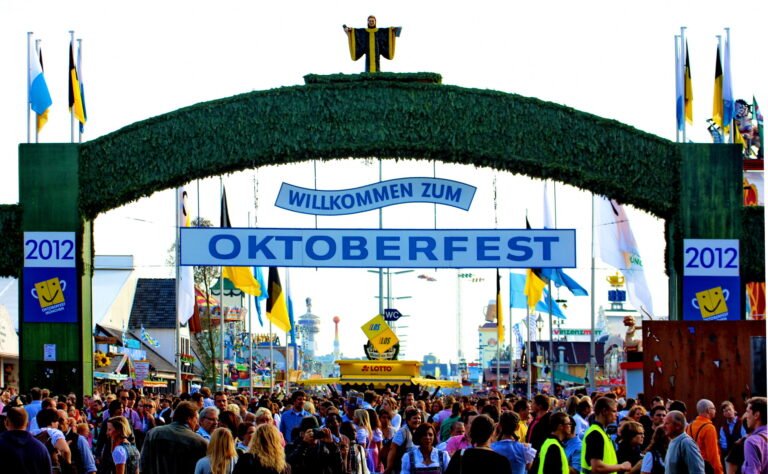Oktoberfest: A Guide to the World’s Largest Folk Festival
1. The Origins of Oktoberfest
Oktoberfest, the world-renowned Bavarian beer festival, has a fascinating history. It all started with a royal wedding that captivated the hearts of Munich’s citizens.
1.1 The Royal Wedding
In October 1810, Crown Prince Ludwig, later King Ludwig I, married Princess Therese of Saxe-Hildburghausen. The citizens of Munich were invited to join in the festivities, which were held over five days on the fields in front of the city gates.
1.2 The First Celebration
The event was so well-received that it became an annual tradition. Over time, the celebration expanded and evolved, incorporating new attractions and customs, solidifying its place in Bavarian culture.
2. Where is Oktoberfest Held?
Oktoberfest is synonymous with Munich, Bavaria’s capital. The festival takes place at Theresienwiese, which translates to “Theresa’s Meadow.”
2.1 Theresienwiese: The Festival Grounds
Theresienwiese, often referred to simply as “Wiesn,” is transformed into a bustling carnival with massive beer tents, amusement rides, and food stalls. It’s a sprawling area that becomes the epicenter of Bavarian culture for a few weeks each year.
3. When is Oktoberfest Celebrated?
The timing of Oktoberfest has shifted slightly over the years but remains a fall tradition.
3.1 The Historical Timing
Originally, the festival began in mid-October to celebrate the royal wedding anniversary. However, due to better weather conditions, the start date was moved to September.
3.2 The Modern Schedule
Today, Oktoberfest kicks off in late September and runs until the first weekend in October, providing a 16-18 day window for visitors to enjoy the festivities.
4. Oktoberfest Traditions
Oktoberfest is steeped in tradition, from the clothing to the beer tents.
4.1 Traditional Attire: Lederhosen and Dirndls
Visitors often don traditional Bavarian attire—men wear lederhosen (leather shorts with suspenders), and women wear dirndls (a dress with a fitted bodice and full skirt). These outfits are not just for show; they are a nod to the festival’s cultural roots.
4.2 The Beer Tents
The beer tents are arguably the heart of Oktoberfest, each offering a unique experience.
4.2.1 The Breweries
Munich’s six major breweries—Augustiner, Hacker-Pschorr, Hofbräu, Löwenbräu, Paulaner, and Spaten—each operate their own tent. Each tent serves its own special brew made specifically for the festival.
4.2.2 The Atmosphere
Inside the tents, long communal tables foster a sense of camaraderie. Visitors from all over the world gather to drink, sing, and enjoy traditional Bavarian music.
4.3 The Parades
Two main parades mark the opening of Oktoberfest. The Costume and Riflemen’s Parade showcases traditional Bavarian costumes, while the Oktoberfest Parade features the breweries’ horse-drawn beer wagons.
4.4 The Music
Traditional brass bands provide the soundtrack to Oktoberfest. The music ranges from traditional Bavarian tunes to modern hits, ensuring there’s something for everyone to enjoy.
5. The Food of Oktoberfest
Oktoberfest is not just about beer; the food is equally important.
5.1 Savory Delights
From hearty sausages (Würstl) to roasted chicken (Hendl), the savory offerings are a carnivore’s dream. Pretzels, larger than your head, are a festival staple, perfect for soaking up the beer.
5.2 Sweet Treats
For those with a sweet tooth, Oktoberfest does not disappoint. Indulge in apple strudel, Kaiserschmarrn (shredded pancakes with raisins), and gingerbread hearts inscribed with sweet messages.
6. Family-Friendly Activities
Despite its reputation for beer, Oktoberfest offers plenty for families.
6.1 Rides and Games
The festival boasts a variety of amusement rides, from traditional carousels to modern roller coasters. Games and attractions cater to both kids and adults, ensuring fun for all ages.
6.2 Kid Zones
Certain areas of the festival are designated for families, with more kid-friendly activities and a focus on safety. These zones provide a respite from the more boisterous beer tents.
7. Tips for First-Time Visitors
Planning your first trip to Oktoberfest? Here are some essential tips.
7.1 What to Wear
Embrace the tradition by wearing a dirndl or lederhosen. Not only will you fit in, but you’ll also feel more connected to the festival’s rich history.
7.2 How to Get There
Public transport is the best way to reach Theresienwiese. Munich’s efficient metro and bus systems will get you there quickly and safely.
7.3 Where to Stay
Book your accommodation well in advance. Options range from luxury hotels to budget-friendly hostels. Consider staying in central Munich to be close to the action.
7.4 Must-See Attractions
Don’t miss the traditional parades, the beer tents, and the historic Bavaria statue overlooking the festival grounds. Each offers a unique slice of the Oktoberfest experience.
8. Oktoberfest Around the World
While Munich hosts the original and largest

